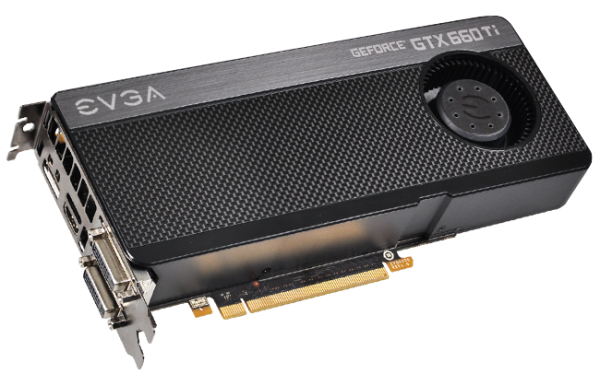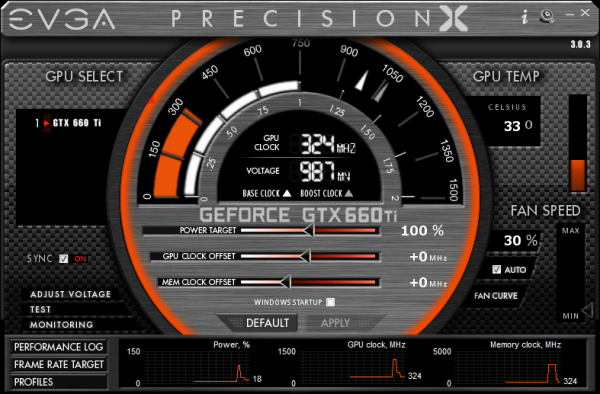The GeForce GTX 660 Ti Review, Feat. EVGA, Zotac, and Gigabyte
by Ryan Smith on August 16, 2012 9:00 AM ESTMeet The EVGA GeForce GTX 660 Ti Superclocked
Our first card of the day is EVGA’s entry, the EVGA GeForce GTX 660 Ti Superclocked. Among all of the GTX 670 cards we’ve looked at and all of the GTX 660 Ti cards we’re going to be looking at, this is the card that is the most like its older sibling. In fact with only a couple cosmetic differences it’s practically identical in construction.
| GeForce GTX 660 Ti Partner Card Specification Comparison | ||||||
| GeForce GTX 660 Ti(Ref) | EVGA GTX 660 Ti Superclocked | Zotac GTX 660 Ti AMP! | Gigabyte GTX 660 Ti OC | |||
| Base Clock | 915MHz | 980MHz | 1033MHz | 1033MHz | ||
| Boost Clock | 980MHz | 1059MHz | 1111MHz | 1111MHz | ||
| Memory Clock | 6008MHz | 6008MHz | 6608MHz | 6008MHz | ||
| Frame Buffer | 2GB | 2GB | 2GB | 2GB | ||
| TDP | 150W | 150W | 150W | ~170W | ||
| Width | Double Slot | Double Slot | Double Slot | Double Slot | ||
| Length | N/A | 9.5" | 7.5" | 10,5" | ||
| Warranty | N/A | 3 Year | 3 Year + Life | 3 Year | ||
| Price Point | $299 | $309 | $329 | $319 | ||
EVGA will be clocking the GTX 660 Ti SC at 980MHz for the base clock and 1059MHz for the boost clock, which represents a 65MHz (7%) and 79MHz (8%) overclock respectively. Meanwhile EVGA has left the memory clocked untouched at 6GHz, the reference memory clockspeed for all of NVIDIA’s GTX 600 parts thus far.
The GTX 660 Ti is otherwise identical to the GTX 670, for all of the benefits that entails. While NVIDIA isn’t shipping a proper reference card for the GTX 660 Ti, they did create a reference design, and this appears to be what it’s based on. Both the EVGA and Zotac cards are using identical PCBs derived from the GTX 670’s PCB, which is not unexpected given the power consumption of the GTX 660 Ti. The only difference we can find on this PCB is that instead of there being solder pads for 16 memory chips there are solder pads for 12, reflecting the fact that the GTX 660 Ti can have at most 12 memory chips attached.
With this PCB design the PCB measures only 6.75” long, with the bulk of the VRM components located at the front of the card rather than the rear. Hynix 2Gb 6GHz memory chips are placed both on the front of the PCB and the back, with 6 on the front and 2 on the rear. The rear chips are directly behind a pair of front chips, reflecting the fact that all 4 of these chips are connected to a single memory controller.
With the effective reuse of the GTX 670 PCB, EVGA is also reusing their GTX 670 cooler. This cooler is a blower, which due to the positioning of the GPU and various electronic components means that the blower fan is off of the PCB entirely by necessity. Instead the blower fan is located behind the card in a piece of enclosed housing. This housing pushes the total length of the card out to 9.5”. Housed inside of the enclosure is a block-style aluminum heatsink with a copper baseplate that is providing cooling for the GPU. Elsewhere, attached to the PCB we’ll see a moderately sized aluminum heatsink clamped down on top of the VRMs towards the front of the card. There is no cooling provided for the GDDR5 RAM.
Elsewhere, at the top of the card we’ll find the 2 PCIe power sockets and 2 SLI connectors. Meanwhile at the front of the card EVGA is using the same I/O port configuration and bracket that we saw with the GTX 670. This means they’re using the NVIDIA standard: 1 DL-DVI-D port, 1 DL-DVI-I port, 1 full size HDMI 1.4 port, and 1 full size DisplayPort 1.2. This also means that the card features EVGA’s high-flow bracket, a bracket with less shielding in order to maximize the amount of air that can be exhausted.
Rounding out the package is EVGA’s typical collection of accessories and knick-knacks. In the box you’ll find a pair of molex power adapters, a quick start guide, and some stickers. The real meat of EVGA’s offering is on their website, where EVGA card owners can download their wonderful video card overclocking utility (Precision X), and their stress test utility (OC Scanner X). The powered-by-RivaTuner Precision X and OC Scanner X still set the gold standard for video card utilities thanks to their functionality and ease of use. Though personally I’m not a fan of the new UI – circular UIs and sliders aren’t particularly easy to read – but it gets the job done.
Next, as with all EVGA cards, the EVGA GeForce GTX 660 Ti Superclocked comes with EVGA’s standard 3 year transferable warranty, with individual 2 or 7 year extensions available for purchase upon registration, which will also unlock access to EVGA’s step-up upgrade program. Finally, the EVGA GeForce GTX 660 Ti Superclocked will be hitting retail with an MSRP of $309, $10 over the MSRP for reference cards.






















313 Comments
View All Comments
Nfarce - Thursday, August 16, 2012 - link
The GTX 680 is 20% higher in performance than the 660Ti but it comes at a lofty 67% higher price tag. The 670 is just 10% faster but still comes at a 33% price premium. I was upset after dropping 5 Benjamins on an EVGA 680 Superclocked when the 670 came out. I should have waited on THAT card and saved a hundred. Now this card is out and two of these in SLI will slaughter my 680 by a 35% margin for just another 20% in cost (according to Guru3D's SLI tests). Just damn on my timing and decisions. Methinks I'm selling the 680 for a $50 loss and get two of these for $600. Sure beats the original plan of spending $1,000 in a 680 SLI setup.CeriseCogburn - Sunday, August 19, 2012 - link
This place and Tom's very conveniently left out the 680 in all the charts but made biased assured that the 7970 was in every single one of them.TheJian - Monday, August 20, 2012 - link
Another 680 at newegg is $499 (lots of choices). Two 680's will smoke the two 660's for $100 less. Since you already own one ;) If you buy two of either, I hope you're going to run them at 5760x1200 (3 monitors or 3840x1200? two monitors?). Wasted power otherwise. 1920x1200 is already 100fps+ in almost everything on a GTX 680.But sorry about you jumping early :) That's the price any of us pay for being first on the block to have the latest toys :) Also note, you can turn down both 680's and have a silent seriously butt kicking machine until you actually need the power. No heat or noise until you actually need it. Let's face it, two 680's is a LOT of freaking performance.
Congrats if you've got an extra $500 laying around in these times :) Might want to wait for labor day specials though ;)
xKrNMBoYx - Thursday, August 16, 2012 - link
Is that a typo or is the Zotac GTX 660 Ti AMP! memory clock 600 MHz fasterRyan Smith - Thursday, August 16, 2012 - link
That's not a typo. They are offering a factory memory overclock; the only such vendor to do so according to the list I have.Jaguar36 - Thursday, August 16, 2012 - link
I'd love to see SC2 come back, particularly with the new Arcade games. Some of them can easily bring even a top card to its knees. The final battle of a Desert Strike game will crush even the best cards.TheJian - Tuesday, August 21, 2012 - link
Nah, I'm sure people would whine because it's another victory for Nvidia at 1920x1200 and below (heck I think above also). They could have benched it as before but Ryan probably wanted to leave it out :) He might have had to make a conclusion then, even at 2560x1600... ;)http://www.anandtech.com/show/6025/radeon-hd-7970-...
Note that article is from 6/22/2012. and they used it again here:
http://www.anandtech.com/show/6096/evga-geforce-gt...
7/22/2012...
You see, at 1920x1200 ULTRA + 4xMSAA the GTX670 already scores 121.2 vs. 108.3 for the 7970GE (7970 only gets 99, and the 7950 gets 88.2fps). So you would have the GTX 660 TI smoking the 7970Ghz edition. That wouldn't look too good when it's supposed to be competing against the 7850/7950...LOL. The GTX 670 even beats the 7970GHZ edition in the 2% market share 2560x1600 also. So it may have looked pretty bad against the 660 here also. It would have made his 2560x1600 digs and conclusion even worse and hard to even argue there. Ryan was smart here...Just not quite smart enough if you look at the big picture of evidence.
Understand why they won't bench SC2 again now? Why not run the last version patch that works fine? Did 1.51 not work too (released 8th? a week ago from review date). Instead he keeps in Warhead from 2008 and an engine from 2007 that was only used in 7 games vs. the much more TAXING Crysis 2 (not 1) with DX11 patch and Ultra res patch which turns on a crapload of stuff like:hardware tessellation, soft shadows with variable penumbra, improved water rendering, particle motion blur and shadowing, Parallax Occlusion Mapping, full-resolution High Dynamic Range motion blur, & hardware-based occlusion culling.
"can it run crysis?"...Wrong question, can it run crysis 2! :) I still think it would be close or a loss for NV though with 660. It would be a close call, probably a wash...But that wouldn't help ryan either :) Hence the 2008 game.
CeriseCogburn - Thursday, August 23, 2012 - link
This place for these vidcards is goners man. Good job.Stas - Thursday, August 16, 2012 - link
Disappointed. Was hoping to see it match 7950 to drive the prices down... But it actually loses to 7950. Let alone o/c potential. Ugh... keep waiting.TheJian - Tuesday, August 21, 2012 - link
I'm not even going to waste my time with this BS comment. But see my response to Ryan's lame excuse over 2560x1600 for all the details you SHOULD have seen in his review (and some that he SHOULD have put IN the review). It only one ONE game @1920x1200. In my response to ryan I prove you can't run at 2560x1600 and stay above 30fps.Nice try though. :) Slower my butt.